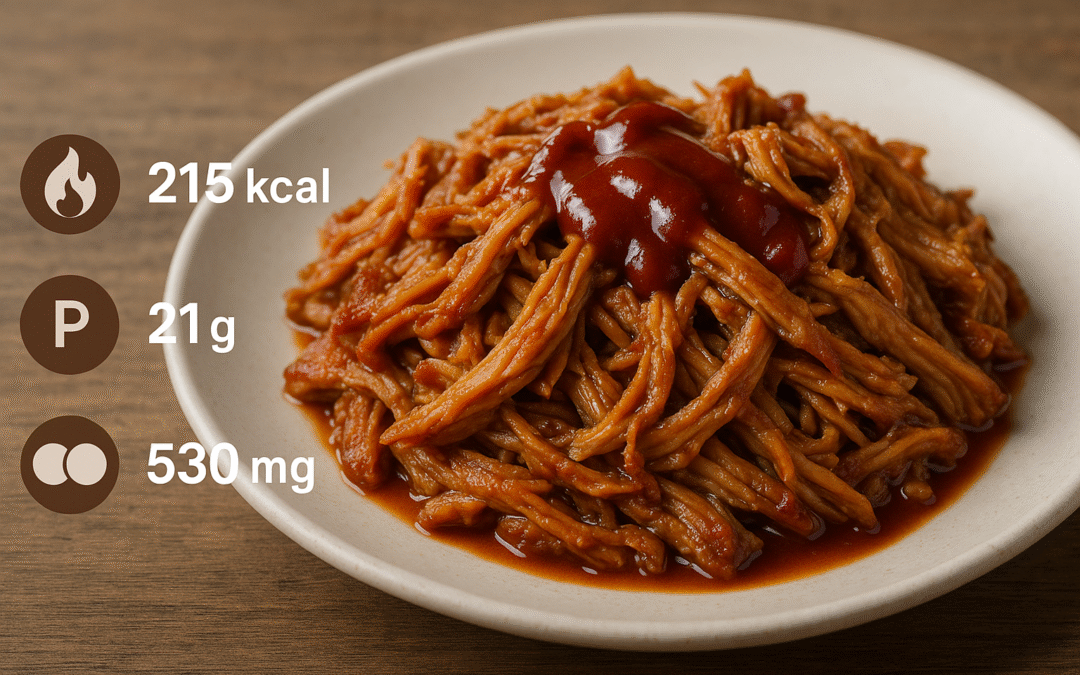Disclaimer
Nutritional values are estimates and vary depending on recipe, sauce type, and portion size. This article is for informational purposes only and not a substitute for professional dietary or medical advice.
Tender, smoky, and full of flavor, barbecue pulled pork is one of America’s most loved comfort foods. Whether it’s piled on a sandwich, served with coleslaw, or eaten on its own, it’s a dish that brings people together at cookouts and family dinners alike.
But when it comes to nutrition, is barbecue pulled pork as wholesome as it is delicious? Understanding barbecue pulled pork nutrition facts helps balance enjoyment with health awareness — especially since preparation methods, sauces, and serving portions can make a big difference in calories, fat, and sodium.
What Is Barbecue Pulled Pork?
Pulled pork is a dish made from slow-cooked pork — often from the shoulder (Boston butt or picnic roast) — that’s cooked until tender enough to “pull” apart into shreds.
The meat is usually seasoned or marinated, then cooked using one of the following methods:
- Smoked slowly over wood or charcoal
- Slow-cooked in a crockpot or oven
- Pressure-cooked for faster results
It’s then mixed with barbecue sauce, which adds flavor but also contributes sugar, sodium, and calories.
Depending on preparation, the same dish can range from lean and nutritious to rich and high in fat.
Barbecue Pulled Pork Nutrition Facts (Per 100 g / 3.5 oz Serving)
| Nutrient | Amount |
|---|---|
| Calories | 215 kcal |
| Protein | 21 g |
| Total Fat | 11 g |
| Saturated Fat | 3.5 g |
| Cholesterol | 70 mg |
| Carbohydrates | 8 g |
| Sugars | 6 g |
| Fiber | 0 g |
| Sodium | 530 mg |
| Iron | 1 mg |
| Potassium | 310 mg |
| Vitamin B6 | 0.5 mg |
| Vitamin B12 | 0.6 µg |
Values are for pulled pork with traditional barbecue sauce. Homemade versions without added sauce can have significantly less sugar and sodium.
Calories in Barbecue Pulled Pork
A typical 3.5 oz (100 g) serving of barbecue pulled pork provides around 200–220 calories.
Here’s where the calories come from:
- Protein: 21 g (84 calories)
- Fat: 11 g (99 calories)
- Carbohydrates (from sauce): 8 g (32 calories)
Sauce-heavy or fatty cuts can raise the calorie count to 300+ calories per serving, especially in sandwiches with buns.
Lean preparation tip: Trim visible fat and use less sauce to cut up to 100 calories per serving.
Protein Content
Pulled pork is a high-protein food, providing around 20–25 grams per serving. Protein helps with:
- Muscle maintenance and repair
- Metabolism support
- Longer satiety between meals
If prepared without excess sauce or oil, pulled pork can be a solid protein source similar to chicken breast — but with a richer flavor profile.
Fat and Cholesterol
Pork shoulder is naturally marbled, which gives it tenderness but also raises fat content.
Each serving provides roughly:
- Total fat: 11 g
- Saturated fat: 3.5 g
- Cholesterol: 70 mg
Saturated fat contributes to taste but should be consumed in moderation.
Using leaner cuts such as pork loin or tenderloin can lower fat content by up to 40%, while still delivering flavor.
Tip: Skim excess fat after slow cooking for a lighter dish.
Carbohydrates and Sugar
Plain pulled pork without sauce contains virtually no carbs.
However, barbecue sauce changes the equation — adding 6–10 grams of sugar per serving, often from ingredients like molasses, brown sugar, or ketchup.
While not excessive in small portions, sugar can accumulate quickly when eaten in sandwiches or combo meals with sweet coleslaw or baked beans.
To reduce carbs:
- Use low-sugar or homemade sauces
- Flavor with vinegar, mustard, or smoked spices instead of sweetened sauces
Sodium Content
Sodium is one of the highest nutritional concerns in barbecue pulled pork.
A single serving can contain 500–700 mg of sodium, mostly from barbecue sauce, spice rubs, and cured meats. Restaurant servings often exceed 1,000 mg, nearly half of the daily recommended limit.
To reduce sodium:
- Choose unsalted seasoning blends
- Make your own sauce with fresh tomatoes and vinegar
- Rinse pre-cooked pulled pork before saucing if it’s pre-packaged
Vitamins and Minerals
Pulled pork offers a decent range of micronutrients, especially from its protein source.
| Nutrient | Function | Amount (per 100 g) |
|---|---|---|
| Vitamin B6 | Energy metabolism, brain health | 0.5 mg |
| Vitamin B12 | Nerve and red blood cell function | 0.6 µg |
| Niacin (B3) | Supports metabolism | 5 mg |
| Iron | Helps transport oxygen in blood | 1 mg |
| Zinc | Immune function | 2 mg |
| Potassium | Muscle and fluid balance | 310 mg |
| Phosphorus | Bone health | 180 mg |
These nutrients make pulled pork a valuable protein source when prepared in moderation and without excessive sauces.
Homemade vs Restaurant Nutrition
| Source | Calories | Protein | Fat | Sodium | Sugar |
|---|---|---|---|---|---|
| Homemade (lean cut, minimal sauce) | 190 | 22 g | 8 g | 300 mg | 3 g |
| Restaurant BBQ (standard sauce) | 250 | 20 g | 12 g | 700 mg | 8 g |
| Fast-food pulled pork sandwich | 450–600 | 28 g | 20 g | 1,000+ mg | 12–15 g |
Homemade versions win nutritionally due to better control over fat, sugar, and salt content.
Health Benefits of Pulled Pork
1. Excellent Source of Protein
Pulled pork delivers complete protein with all nine essential amino acids, supporting tissue repair, immune strength, and muscle maintenance.
2. Rich in B Vitamins
It’s especially high in vitamin B6 and niacin, which support metabolism and cognitive health.
3. Provides Important Minerals
Iron and zinc in pork support oxygen transport and immune system function — particularly beneficial for people with higher nutrient needs.
4. Can Fit in a Balanced Diet
When made with lean cuts and moderate sauce, pulled pork can serve as a healthy part of a high-protein meal plan.
Potential Drawbacks
1. High in Fat
Depending on the cut, pulled pork can have significant saturated fat, which should be limited to less than 10% of daily calories.
2. High Sodium Content
Excess sodium may contribute to hypertension or fluid retention, especially in prepackaged or restaurant servings.
3. Added Sugars in Barbecue Sauce
Commercial sauces often contain refined sugars that add empty calories.
4. Portion Size Creep
A typical serving size is 3–4 ounces, but restaurant portions often double, increasing calorie and sodium intake.
Barbecue Sauce and Its Nutritional Impact
| Type of Sauce | Calories (2 tbsp) | Sugar | Sodium |
|---|---|---|---|
| Traditional Sweet BBQ | 60 | 10 g | 250 mg |
| Smoky or Spicy BBQ | 50 | 8 g | 230 mg |
| Honey BBQ | 70 | 12 g | 270 mg |
| Sugar-Free or Low-Sodium | 25 | 1 g | 100 mg |
Even small amounts of sauce can shift the overall nutritional balance. Choosing vinegar-based or sugar-free sauces helps keep pulled pork lighter without sacrificing taste.
How to Make Healthier Pulled Pork
1. Choose Lean Cuts:
Opt for pork tenderloin or loin roast instead of shoulder. These cuts have less marbling and fat.
2. Trim Visible Fat:
Before cooking, remove outer fat layers to reduce saturated fat content.
3. Use Dry Rubs Instead of Heavy Sauces:
Season with paprika, garlic powder, cumin, and black pepper for natural flavor.
4. Make Homemade BBQ Sauce:
Blend tomato paste, apple cider vinegar, and spices for a low-sugar, low-sodium alternative.
5. Control Portions:
Stick to 3–4 ounces of meat per serving, especially when paired with sides like bread or potatoes.
Pulled Pork in a Sandwich vs Plate
| Preparation | Calories | Protein | Fat | Sodium | Notes |
|---|---|---|---|---|---|
| Pulled Pork Only (100 g) | 215 | 21 g | 11 g | 530 mg | Balanced protein source |
| Pulled Pork Sandwich | 480 | 26 g | 18 g | 900 mg | Adds refined carbs and sugar |
| Pulled Pork with Coleslaw | 400 | 23 g | 15 g | 700 mg | Healthier when slaw is vinegar-based |
Pairing pulled pork with whole-grain buns or vegetable sides helps make it a more balanced meal.
Pulled Pork vs Other Barbecue Meats
| Meat Type | Calories (per 100 g) | Protein | Fat | Sodium |
|---|---|---|---|---|
| Pulled Pork (with sauce) | 215 | 21 g | 11 g | 530 mg |
| Grilled Chicken Breast | 165 | 31 g | 3.5 g | 70 mg |
| Beef Brisket (with sauce) | 250 | 24 g | 15 g | 600 mg |
| Pulled Chicken (with sauce) | 190 | 23 g | 7 g | 480 mg |
Pulled pork ranks in the middle range — higher in fat than chicken, but lower than brisket. When prepared lean, it can be a flavorful, moderate-protein choice.
Healthy Side Pairings
To make a balanced barbecue meal:
- Add Fiber: Pair with coleslaw (vinegar-based), roasted vegetables, or a small salad.
- Balance Carbs: Use whole-grain or thin sandwich buns.
- Control Sugars: Limit sweet sides like baked beans or cornbread.
- Hydrate: Choose water or unsweetened iced tea instead of sugary drinks.
These adjustments turn a hearty comfort food into a nutritionally rounded meal.
Quick Recap of Barbecue Pulled Pork Nutrition
| Nutrient | Value (Per 100 g) |
|---|---|
| Calories | 215 kcal |
| Protein | 21 g |
| Fat | 11 g |
| Saturated Fat | 3.5 g |
| Carbohydrates | 8 g |
| Sugars | 6 g |
| Sodium | 530 mg |
| Cholesterol | 70 mg |
| Iron | 1 mg |
| Potassium | 310 mg |
The Bottom Line
Barbecue pulled pork can be both delicious and nutritious when prepared thoughtfully. It’s a great source of high-quality protein and essential B vitamins, but can also be high in sodium, saturated fat, and sugar when drenched in sauce.
For a healthier version, go light on the sauce, use lean cuts, and pair it with fiber-rich sides. Enjoy it as part of a balanced meal rather than the main calorie source.
Smoky, tender, and satisfying — pulled pork doesn’t have to be indulgent to be enjoyable. With mindful preparation, it can fit comfortably into a wholesome diet.

